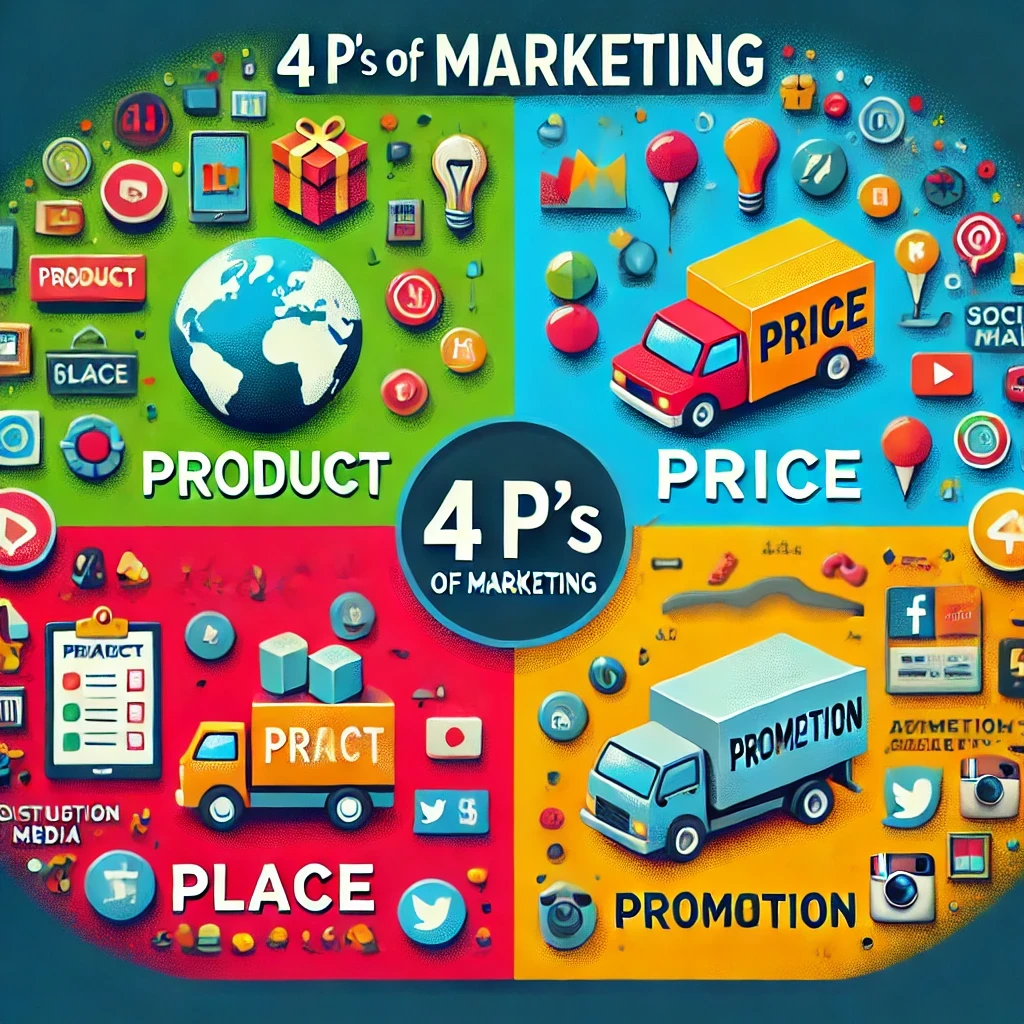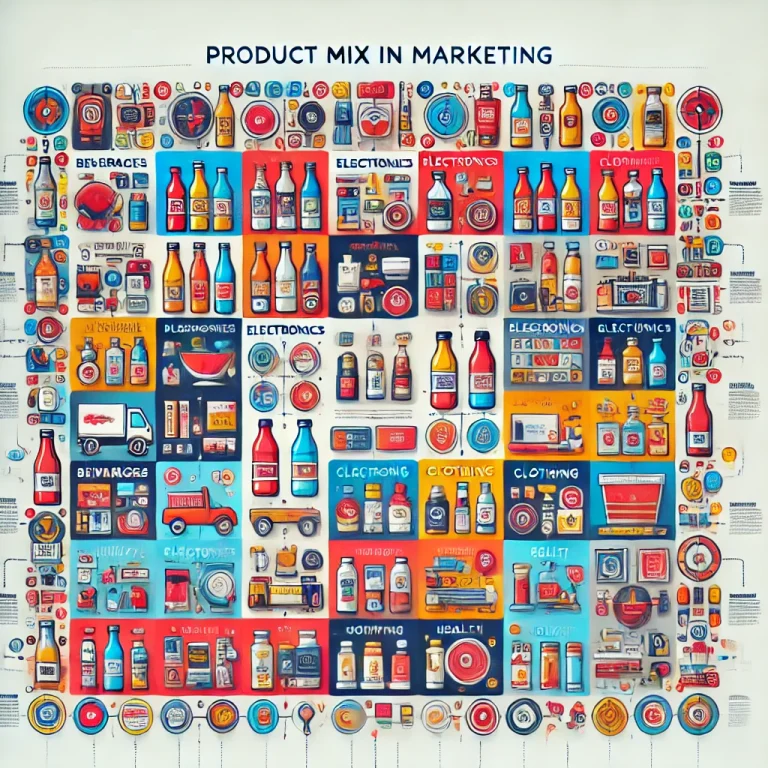Product mix in marketing refers to the complete set of products that a business provides to its clients. It is all lines of products as well as individual items, which are offered to offer solutions for diverse requirements of different customer needs and segments of the market. Proper management of a product mix enables businesses to fully utilize their sales potential, attract various target audiences, and compete effectively in the market. Moreover, it is also imperative for formulating the right strategies of marketing, improvement in brand value, and maximization of profitability.
What is Product Mix in Marketing?
A product mix in marketing is also referred to as the product assortment. This refers to the full collection of product lines and the individual items that a company makes available to its customers. A product mix, therefore, defines the company’s overall strategy in terms of the variety and diversity of its offerings-the optimum distribution of a product line’s various items. An appropriate product mix allows an enterprise to meet different consumer needs and thus capture a broad market share.
Dimensions of a Product Mix
The dimensions of a product mix are essential to understand how a business organizes its offerings:
- Width: The width of a product mix is defined as the number of different product lines offered by the company. A company, for example, Procter & Gamble, offers various product lines, which might include skincare, hair care, or household items.
- Length: The length implies the total number of products within the product lines of the company. For example, if a company has three product lines with ten products in each then the length of its product mix is 30.
- Depth: It refers to the diversity of products in one line. In this particular scenario, product variations are provided in all aspects of size, flavor, color, and other sources. Varied variants for the same product do satisfy customer preferences, hence claiming a deep product mix.
- Consistency: This is the degree to which the various product lines are related in terms of their usage, process of manufacturing, or even the channels of distribution. A consistent product mix ensures that the brand possesses a well-defined identity and functions at higher efficiencies.
Types of Products in Marketing Mix
A defined product mix is composed of various types of products catering to diverse customers. Marketing divides products into two primary heads: consumer products and industrial products.
Consumer Products
Consumer products are those that are purchased by individuals for personal use. They can be further divided into four subcategories:
- Convenience Products: Those that are frequently purchased, usually requiring very little or no mental effort at all, like snacks, beverages, and household goods. Sold at low prices and ubiquitous in retail stores.
- Shopping Products: Those that consumers compare on attributes about quality, price, and style before purchasing and include apparel, electronic devices, and appliances. Heavier consumer involvement and effort.
- High-brand Products with Distinctiveness: Luxury cars, designer outfits, and high-tech devices: consumers are willing to go to a great extent to buy these products due to brand loyalty or specific needs.
- Unsought Products: Products that consumers do not seek out or, at minimum, are unaware of until a need arises, such as life insurance or emergency medical supplies. These require that marketing and sales efforts have the role of promoting the product and making people aware of its existence.
Industrial Products
Industrial products are purchased for use in business operations, production processes, or reselling purposes. They include:
- Raw Materials: Some of the key inputs a manufacturer employs while creating a product, are metals, chemicals, and minerals. These are absolutely essential to manufacturing and production-driven ventures.
- Capital Goods: Products in an organization that is employed during the production cycle for more extended periods, like machinery, buildings, and other vehicles. These products have a longer life cycle and are very important to the organization.
- Supplies and Services: Items like office supplies, maintenance services, and cleaning products that support the functions of a business but do not relate to the production process.

Difference Between Product Line and Product Mix
The difference between product line and product mix is an essential concept in marketing strategy, as it helps businesses distinguish between their various offerings.
- Product Line: A product line is a related product, that can be marketed under a single brand, though they vary in size, flavor, or other characteristics. For example, a product line in Coca-Cola would include Coke, Diet Coke, and Coke Zero.
- Product Mix: Product mix simply refers to the whole portfolio of products that a company offers. Alternatively, it’s all the lines of products offered by a given company. For instance, the product mix of PepsiCo encompasses beverages such as Pepsi and Mountain Dew, while it also encompasses snacks in the form of Lay’s and Doritos.
| Aspect | Product Line | Product Mix |
|---|---|---|
| Definition | A range of similar products | Total collection of all product lines |
| Focus | Specific category or brand | Entire range of offerings |
| Purpose | Targets a particular market segment | Targets multiple market segments |
| Flexibility | Easier to modify or expand | Requires strategic planning for changes |
Product Mix Pricing Strategies in Marketing
Pricing plays a significant role in the success of a company’s product mix strategy. The product mix pricing strategies in marketing include various techniques that can be applied to optimize revenue and market positioning.
- Product Line Pricing: Under this policy, there will be a specific price for products belonging to the same line based on features, quality, or functionality. For instance, several different grades of smartphones are on the market basic-grade model and one mid-range and premium model.
- Optional-Product Pricing: It is the pricing of optional or accessory products that come with the primary product. For example, adding a charge for downgrading from a standard car to a luxury car model.
- Captive Product Pricing: Sells the main product at a low price but significantly higher for important complementary products. For example, printers are sold cheap, but their cartridges cost a fortune.
- Product Bundle Pricing: Collates several related items together and offers them at a price that is significantly cheaper than buying them individually. Examples include streaming service subscription packages or combo deals in fast-food stalls.
- Psychological Pricing: This is the tactic of prices set slightly below round numbers; in other words, $9.99 rather than $10. This tactic involves playing off of the psychological decision-making of the customer.

Factors Affecting Product Mix
The development and evolution of a company’s product mix depend on several key factors, including market dynamics, competition, internal resources, and business objectives.
- Market Trends: Changes in consumer preferences and demand in the market create significant fluctuation in product mix. Eco-friendly products or tech innovations can help a brand become more relevant.
- Competitor Strategies: Competitor actions must be watched for a business to decide whether to expand or change its product mix. If a competitor enters a new product line, a firm may have to innovate also.
- Profit Margins: The company may focus on high-margin products in the product mix that maximize revenues. The product lines that have low margins may be eliminated or phased out as they do not add to growth.
- Production Capacity: The product mix strategy in a company will depend upon the efficiency with which the company can manufacture or acquire products. Low capacities may limit the number of products a company can offer to its customers.
- Company Objectives: Such as market penetration, brand diversification, and revenue growth guide the direction of the product mix. Making long-term business objectives align with the product mix will make it sustainable and market-leading.
Adapting the product mix based on these factors helps businesses maintain a dynamic and customer-centric approach in an ever-changing market.
Conclusion
Product mix is the marketing term to describe that dynamic element in every business strategy that has a critical influence on both the market position and profitability. Proper product lines can be managed by adding strategic prices to the business while conscious of the several factors affecting the product mix so that businesses can conveniently meet the varied needs of consumers within the market and easily remain competitive. Adaptation and innovation within the product mix ensure long-term growth, brand strength, and customer loyalty.
Product Mix in Marketing FAQs
What are the dimensions of a product mix in marketing?
The dimensions include width, length, depth, and consistency, which help in organizing a company’s product strategy.
How do product mix pricing strategies impact profitability?
These strategies, such as product line pricing and optional-product pricing, help optimize prices across various product lines to attract customers and increase revenue.
What is the primary difference between product line and product mix?
A product line focuses on similar products grouped together, while the product mix includes all product lines a company offers.
Why is consistency important in a product mix?
Consistency ensures all product lines align with the company’s brand image and production capabilities, fostering a stronger market presence.
What factors affect the product mix strategy of a business?
Key factors include market trends, competitor strategies, profit margins, production capacity, and company objectives.


